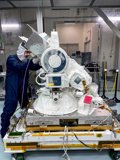Oct. 18 () –
The 31st resupply mission SpaceX for NASA will send to the International Space Station studies on the solar wind, a radiation-tolerant moss, spacecraft materials and cold welding in space, the agency said. Both organizations plan to launch the SpaceX Dragon spacecraft from Launch Complex 39A at NASA’s Kennedy Space Center in Florida (USA) no earlier than Wednesday, October 30.
Thus, the CODEX (COronal Diagnostic Experiment) aims to develop a set of data that will help scientists to validate theories about what heats the solar wind a million degrees hotter than the surface of the Sun and what transmits it at almost a million miles per hour (or what is the same, at almost 1,609,344 kilometers per hour).
Specifically, the research uses a coronagraph, an instrument that blocks direct sunlight to reveal details of the outer atmosphere or corona. Apart from the density information collected by traditional coronagraphs, this instrument takes multiple measurements throughout the day that determine the temperature and speed of electrons in the solar wind.
Furthermore, ARTEMOSS (ANT1 Radiation Tolerance Experiment with Moss in Orbit on the Space Station) will use a live Antarctic moss, Ceratodon purpureus, to study how some plants tolerate radiation exposure better and to examine the physical and genetic response of biological systems to the combination of cosmic radiation and microgravity.
Among other issues, the results of the study could help identify biological systems suitable for use in bioregenerative life support systems in future missions. In addition, it is possible that it could recognize which genes are involved in the adaptation of plants to space flight, which in turn could be modified to create strains tolerant to deep space conditions.
COLD WELDING TO REPAIR SHIPS FROM THE INSIDE
As detailed by NASA, the European Space Agency’s (ESA) ‘Euro Material Aging’ research includes two experiments that study how certain materials age when exposed to space.
The first includes selected materials from 15 European entities. Meanwhile, the second will analyze organic samples and their stability or degradation when exposed to ultraviolet radiation not filtered by the Earth’s atmosphere. Within the framework of this studyresults could support better spacecraft and satellite designwhich would include superior thermal control, as well as the development of sensors for research and industrial applications.
Finally, Nanolab Astrobeat will investigate the use of cold welding to repair holes in the outer shell or hull of a spacecraft from the inside. In the opinion of the US agency, the results could also improve the applications of cold welding on Earth.
In parallel, this study also includes a collaboration with cellist Tina Guo, with the support of New York University in Abu Dhabi, focused on storing musical compositions on the Astrobeat computer. The researchers They have planned to transmit this “space music” after launch from the station to the International Astronautical Congress in Milan and Abu Dhabi.
















Add Comment